Scattering from a Potential
VerifiedAdded on 2023/03/29
|7
|1748
|483
AI Summary
This document explores the concept of scattering from a potential, focusing on the behavior of particles in classical and quantum systems. It investigates the effect of potential barriers on wavefunctions and calculates transmission and reflection coefficients. The document also explores quantum tunneling and wave packets, and discusses the limitations of deterministic systems in quantum mechanics.
Contribute Materials
Your contribution can guide someone’s learning journey. Share your
documents today.
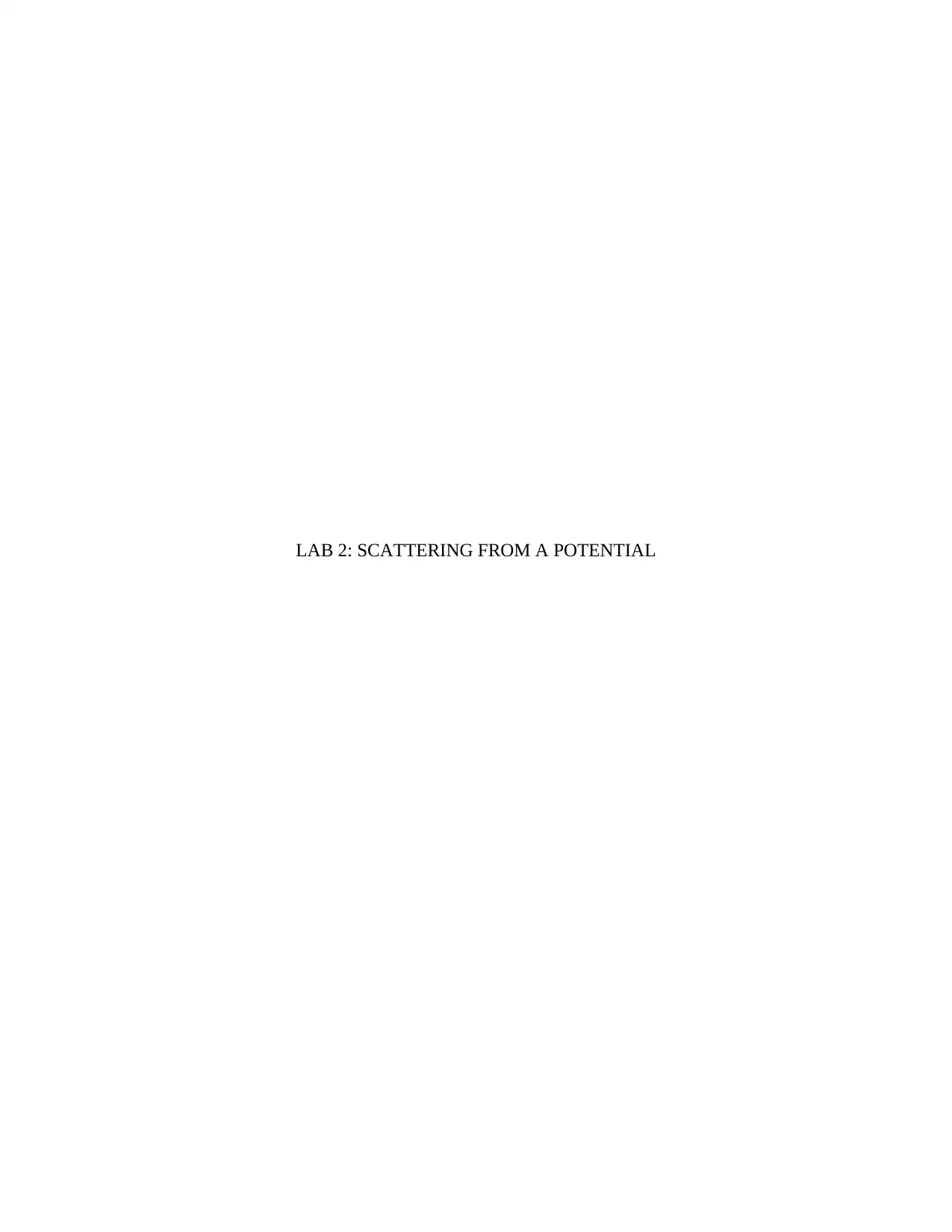
LAB 2: SCATTERING FROM A POTENTIAL
Secure Best Marks with AI Grader
Need help grading? Try our AI Grader for instant feedback on your assignments.
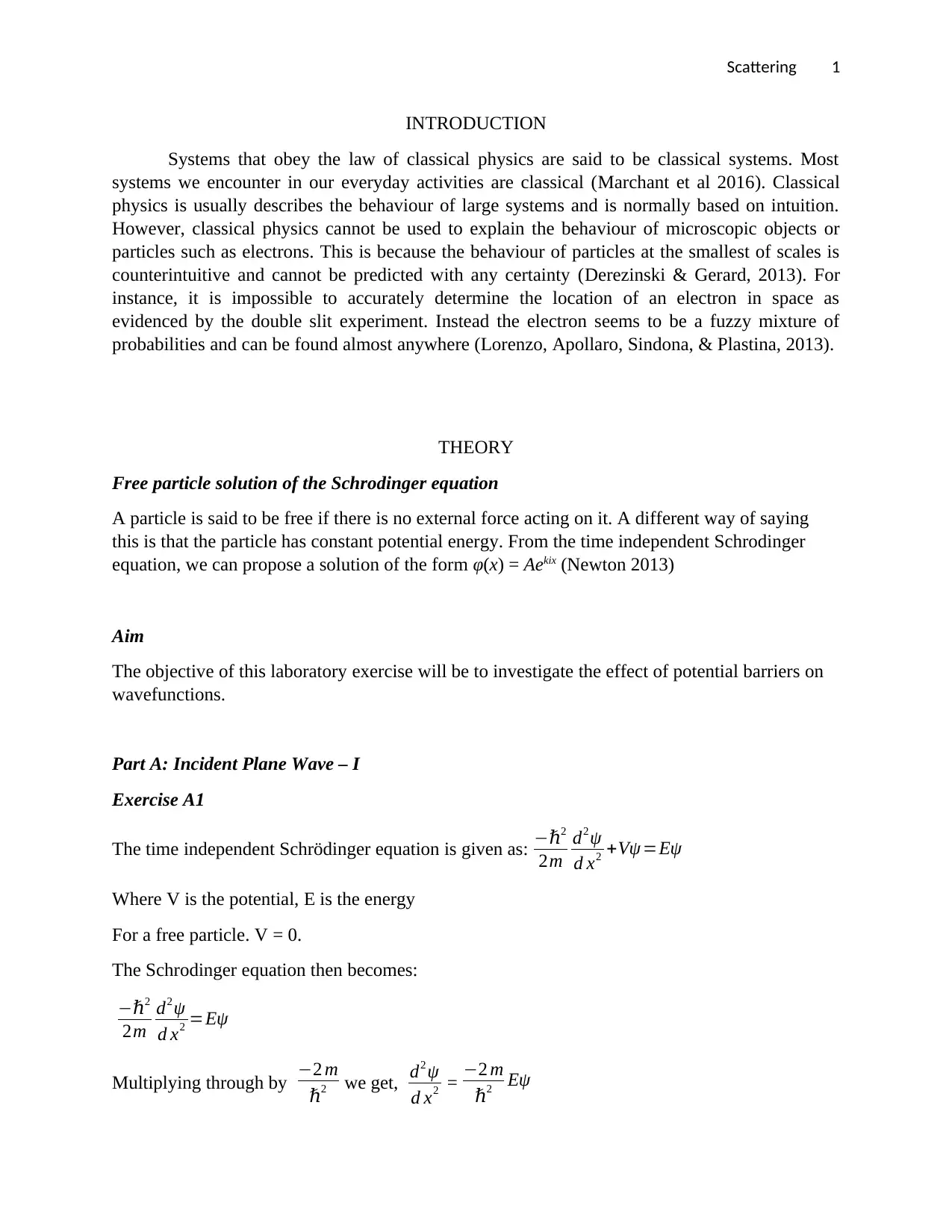
Scattering 1
INTRODUCTION
Systems that obey the law of classical physics are said to be classical systems. Most
systems we encounter in our everyday activities are classical (Marchant et al 2016). Classical
physics is usually describes the behaviour of large systems and is normally based on intuition.
However, classical physics cannot be used to explain the behaviour of microscopic objects or
particles such as electrons. This is because the behaviour of particles at the smallest of scales is
counterintuitive and cannot be predicted with any certainty (Derezinski & Gerard, 2013). For
instance, it is impossible to accurately determine the location of an electron in space as
evidenced by the double slit experiment. Instead the electron seems to be a fuzzy mixture of
probabilities and can be found almost anywhere (Lorenzo, Apollaro, Sindona, & Plastina, 2013).
THEORY
Free particle solution of the Schrodinger equation
A particle is said to be free if there is no external force acting on it. A different way of saying
this is that the particle has constant potential energy. From the time independent Schrodinger
equation, we can propose a solution of the form φ(x) = Aekix (Newton 2013)
Aim
The objective of this laboratory exercise will be to investigate the effect of potential barriers on
wavefunctions.
Part A: Incident Plane Wave – I
Exercise A1
The time independent Schrödinger equation is given as: −ℏ2
2m
d2 ψ
d x2 +Vψ=Eψ
Where V is the potential, E is the energy
For a free particle. V = 0.
The Schrodinger equation then becomes:
−ℏ2
2m
d2 ψ
d x2 =Eψ
Multiplying through by −2 m
ℏ2 we get, d2 ψ
d x2 = −2 m
ℏ2 Eψ
INTRODUCTION
Systems that obey the law of classical physics are said to be classical systems. Most
systems we encounter in our everyday activities are classical (Marchant et al 2016). Classical
physics is usually describes the behaviour of large systems and is normally based on intuition.
However, classical physics cannot be used to explain the behaviour of microscopic objects or
particles such as electrons. This is because the behaviour of particles at the smallest of scales is
counterintuitive and cannot be predicted with any certainty (Derezinski & Gerard, 2013). For
instance, it is impossible to accurately determine the location of an electron in space as
evidenced by the double slit experiment. Instead the electron seems to be a fuzzy mixture of
probabilities and can be found almost anywhere (Lorenzo, Apollaro, Sindona, & Plastina, 2013).
THEORY
Free particle solution of the Schrodinger equation
A particle is said to be free if there is no external force acting on it. A different way of saying
this is that the particle has constant potential energy. From the time independent Schrodinger
equation, we can propose a solution of the form φ(x) = Aekix (Newton 2013)
Aim
The objective of this laboratory exercise will be to investigate the effect of potential barriers on
wavefunctions.
Part A: Incident Plane Wave – I
Exercise A1
The time independent Schrödinger equation is given as: −ℏ2
2m
d2 ψ
d x2 +Vψ=Eψ
Where V is the potential, E is the energy
For a free particle. V = 0.
The Schrodinger equation then becomes:
−ℏ2
2m
d2 ψ
d x2 =Eψ
Multiplying through by −2 m
ℏ2 we get, d2 ψ
d x2 = −2 m
ℏ2 Eψ
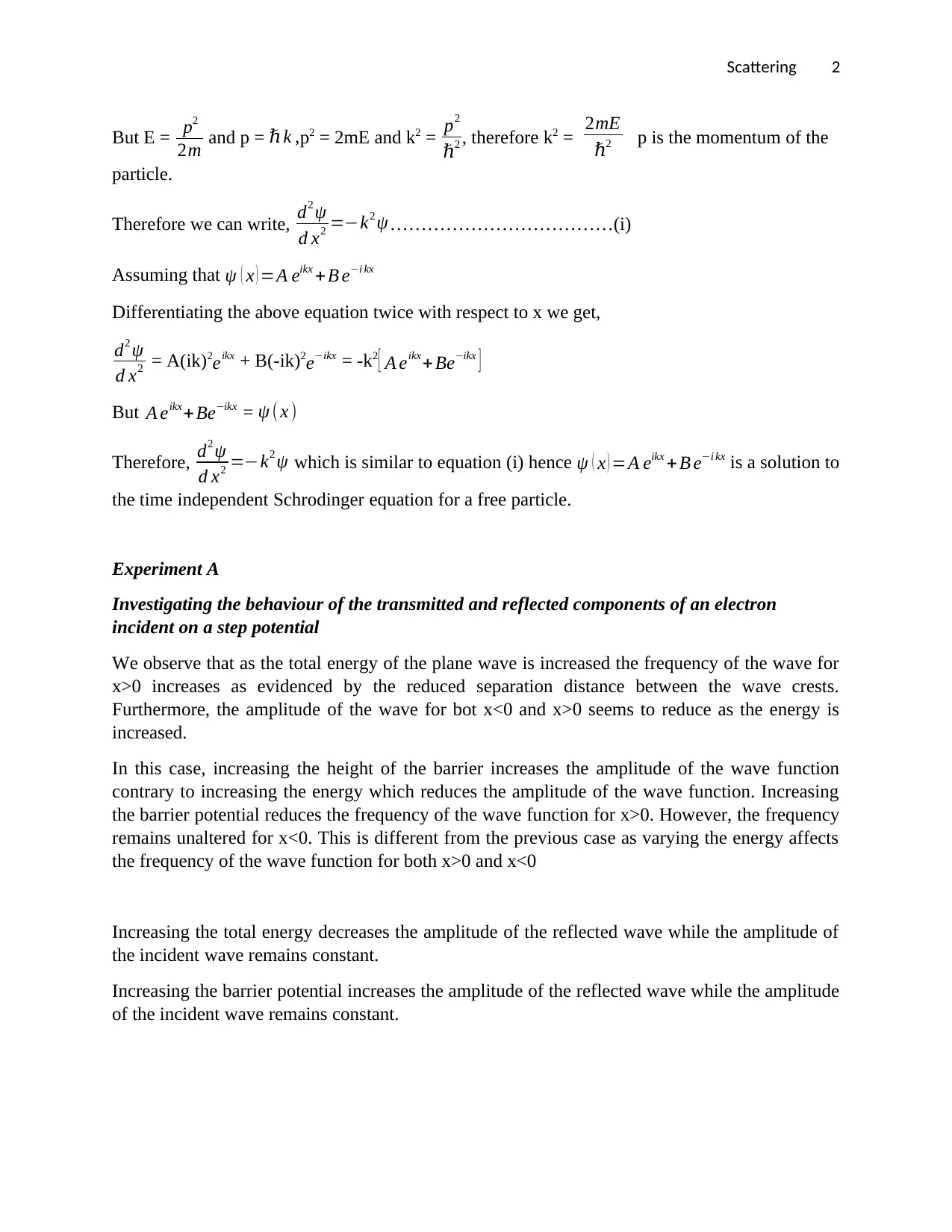
Scattering 2
But E = p2
2m and p = ℏ k ,p2 = 2mE and k2 = p2
ℏ2 , therefore k2 = 2mE
ℏ2 p is the momentum of the
particle.
Therefore we can write, d2 ψ
d x2 =−k2 ψ………………………………(i)
Assuming that ψ ( x ) =A eikx +B e−i kx
Differentiating the above equation twice with respect to x we get,
d2 ψ
d x2 = A(ik)2
eikx + B(-ik)2e−ikx = -k2
[ A eikx+ Be−ikx ]
But A eikx+ Be−ikx = ψ ( x )
Therefore, d2 ψ
d x2 =−k2 ψ which is similar to equation (i) hence ψ ( x ) =A eikx + B e−i kx is a solution to
the time independent Schrodinger equation for a free particle.
Experiment A
Investigating the behaviour of the transmitted and reflected components of an electron
incident on a step potential
We observe that as the total energy of the plane wave is increased the frequency of the wave for
x>0 increases as evidenced by the reduced separation distance between the wave crests.
Furthermore, the amplitude of the wave for bot x<0 and x>0 seems to reduce as the energy is
increased.
In this case, increasing the height of the barrier increases the amplitude of the wave function
contrary to increasing the energy which reduces the amplitude of the wave function. Increasing
the barrier potential reduces the frequency of the wave function for x>0. However, the frequency
remains unaltered for x<0. This is different from the previous case as varying the energy affects
the frequency of the wave function for both x>0 and x<0
Increasing the total energy decreases the amplitude of the reflected wave while the amplitude of
the incident wave remains constant.
Increasing the barrier potential increases the amplitude of the reflected wave while the amplitude
of the incident wave remains constant.
But E = p2
2m and p = ℏ k ,p2 = 2mE and k2 = p2
ℏ2 , therefore k2 = 2mE
ℏ2 p is the momentum of the
particle.
Therefore we can write, d2 ψ
d x2 =−k2 ψ………………………………(i)
Assuming that ψ ( x ) =A eikx +B e−i kx
Differentiating the above equation twice with respect to x we get,
d2 ψ
d x2 = A(ik)2
eikx + B(-ik)2e−ikx = -k2
[ A eikx+ Be−ikx ]
But A eikx+ Be−ikx = ψ ( x )
Therefore, d2 ψ
d x2 =−k2 ψ which is similar to equation (i) hence ψ ( x ) =A eikx + B e−i kx is a solution to
the time independent Schrodinger equation for a free particle.
Experiment A
Investigating the behaviour of the transmitted and reflected components of an electron
incident on a step potential
We observe that as the total energy of the plane wave is increased the frequency of the wave for
x>0 increases as evidenced by the reduced separation distance between the wave crests.
Furthermore, the amplitude of the wave for bot x<0 and x>0 seems to reduce as the energy is
increased.
In this case, increasing the height of the barrier increases the amplitude of the wave function
contrary to increasing the energy which reduces the amplitude of the wave function. Increasing
the barrier potential reduces the frequency of the wave function for x>0. However, the frequency
remains unaltered for x<0. This is different from the previous case as varying the energy affects
the frequency of the wave function for both x>0 and x<0
Increasing the total energy decreases the amplitude of the reflected wave while the amplitude of
the incident wave remains constant.
Increasing the barrier potential increases the amplitude of the reflected wave while the amplitude
of the incident wave remains constant.

Scattering 3
Exercise A2
Calculation of transmission and reflection co-efficients
From k2 = 2m
ℏ ( E−V ) , k = √ 2 m
ℏ ( E−V )
K1 =
√ 2 × 9.11× 10−31
6.626 ×10−34
2 π
( 0.81−0 ) = 118.30
K2 =
√ 2 × 9.11× 10−31
6.626 ×10−34
2 π
( 0.81−0.50 ) = 73.18
R =
( 1− k2
k1
1+ k2
k1
)2
=
( 1− 73.18
118.3
1+73.18
118.3 )2
=0.056
T = 1-R = 1-0.056 = 0.944
For total energy lower than the potential for x > 0
As the total energy of the electron is varied while being maintained below the potential of the
barrier, the transmitted wave almost vanishes completely as the.
As the total energy decreases below the potential of the barrier, the wavelength of the of the
incident wave increases corresponding to a decrease in the frequency.
Part B: Incident Plane Wave – II
Increasing the total energy of the wave function increases decreases the wavelength of both the
incident and the transmitted waves. Furthermore, the increase in total energy results in an
increase in the amplitude of the transmitted wave while decreasing the amplitude of the incident
wave.
Increasing the height of the barrier potential increases the amplitude of the incident wave while
decreasing the amplitude of the transmitted wave simultaneously.
Changing the height of the barrier while the total energy is maintained below the barrier height
only seems to affect the position of the wave shifting it slightly to the right as the potential is
reduced.
Exercise A2
Calculation of transmission and reflection co-efficients
From k2 = 2m
ℏ ( E−V ) , k = √ 2 m
ℏ ( E−V )
K1 =
√ 2 × 9.11× 10−31
6.626 ×10−34
2 π
( 0.81−0 ) = 118.30
K2 =
√ 2 × 9.11× 10−31
6.626 ×10−34
2 π
( 0.81−0.50 ) = 73.18
R =
( 1− k2
k1
1+ k2
k1
)2
=
( 1− 73.18
118.3
1+73.18
118.3 )2
=0.056
T = 1-R = 1-0.056 = 0.944
For total energy lower than the potential for x > 0
As the total energy of the electron is varied while being maintained below the potential of the
barrier, the transmitted wave almost vanishes completely as the.
As the total energy decreases below the potential of the barrier, the wavelength of the of the
incident wave increases corresponding to a decrease in the frequency.
Part B: Incident Plane Wave – II
Increasing the total energy of the wave function increases decreases the wavelength of both the
incident and the transmitted waves. Furthermore, the increase in total energy results in an
increase in the amplitude of the transmitted wave while decreasing the amplitude of the incident
wave.
Increasing the height of the barrier potential increases the amplitude of the incident wave while
decreasing the amplitude of the transmitted wave simultaneously.
Changing the height of the barrier while the total energy is maintained below the barrier height
only seems to affect the position of the wave shifting it slightly to the right as the potential is
reduced.
Secure Best Marks with AI Grader
Need help grading? Try our AI Grader for instant feedback on your assignments.
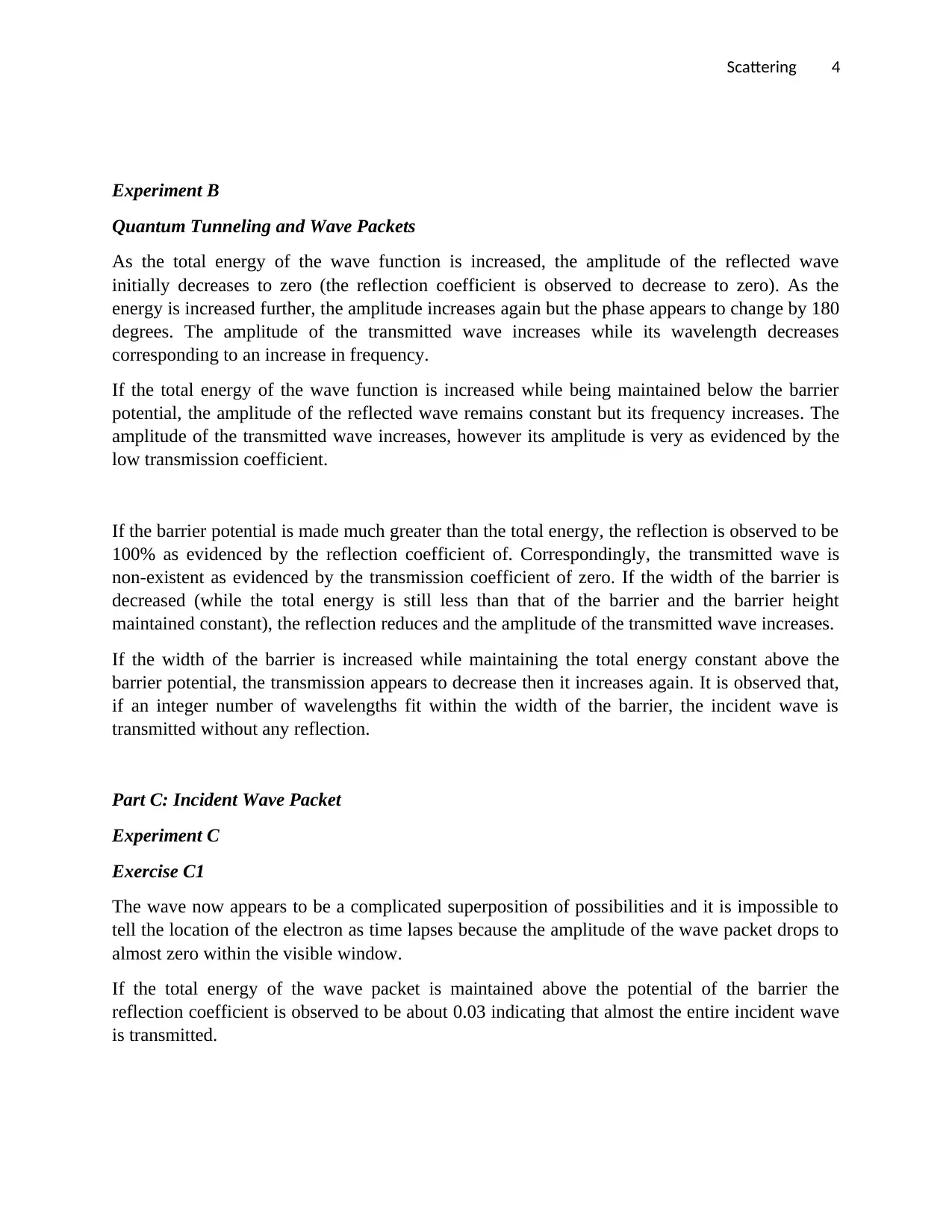
Scattering 4
Experiment B
Quantum Tunneling and Wave Packets
As the total energy of the wave function is increased, the amplitude of the reflected wave
initially decreases to zero (the reflection coefficient is observed to decrease to zero). As the
energy is increased further, the amplitude increases again but the phase appears to change by 180
degrees. The amplitude of the transmitted wave increases while its wavelength decreases
corresponding to an increase in frequency.
If the total energy of the wave function is increased while being maintained below the barrier
potential, the amplitude of the reflected wave remains constant but its frequency increases. The
amplitude of the transmitted wave increases, however its amplitude is very as evidenced by the
low transmission coefficient.
If the barrier potential is made much greater than the total energy, the reflection is observed to be
100% as evidenced by the reflection coefficient of. Correspondingly, the transmitted wave is
non-existent as evidenced by the transmission coefficient of zero. If the width of the barrier is
decreased (while the total energy is still less than that of the barrier and the barrier height
maintained constant), the reflection reduces and the amplitude of the transmitted wave increases.
If the width of the barrier is increased while maintaining the total energy constant above the
barrier potential, the transmission appears to decrease then it increases again. It is observed that,
if an integer number of wavelengths fit within the width of the barrier, the incident wave is
transmitted without any reflection.
Part C: Incident Wave Packet
Experiment C
Exercise C1
The wave now appears to be a complicated superposition of possibilities and it is impossible to
tell the location of the electron as time lapses because the amplitude of the wave packet drops to
almost zero within the visible window.
If the total energy of the wave packet is maintained above the potential of the barrier the
reflection coefficient is observed to be about 0.03 indicating that almost the entire incident wave
is transmitted.
Experiment B
Quantum Tunneling and Wave Packets
As the total energy of the wave function is increased, the amplitude of the reflected wave
initially decreases to zero (the reflection coefficient is observed to decrease to zero). As the
energy is increased further, the amplitude increases again but the phase appears to change by 180
degrees. The amplitude of the transmitted wave increases while its wavelength decreases
corresponding to an increase in frequency.
If the total energy of the wave function is increased while being maintained below the barrier
potential, the amplitude of the reflected wave remains constant but its frequency increases. The
amplitude of the transmitted wave increases, however its amplitude is very as evidenced by the
low transmission coefficient.
If the barrier potential is made much greater than the total energy, the reflection is observed to be
100% as evidenced by the reflection coefficient of. Correspondingly, the transmitted wave is
non-existent as evidenced by the transmission coefficient of zero. If the width of the barrier is
decreased (while the total energy is still less than that of the barrier and the barrier height
maintained constant), the reflection reduces and the amplitude of the transmitted wave increases.
If the width of the barrier is increased while maintaining the total energy constant above the
barrier potential, the transmission appears to decrease then it increases again. It is observed that,
if an integer number of wavelengths fit within the width of the barrier, the incident wave is
transmitted without any reflection.
Part C: Incident Wave Packet
Experiment C
Exercise C1
The wave now appears to be a complicated superposition of possibilities and it is impossible to
tell the location of the electron as time lapses because the amplitude of the wave packet drops to
almost zero within the visible window.
If the total energy of the wave packet is maintained above the potential of the barrier the
reflection coefficient is observed to be about 0.03 indicating that almost the entire incident wave
is transmitted.
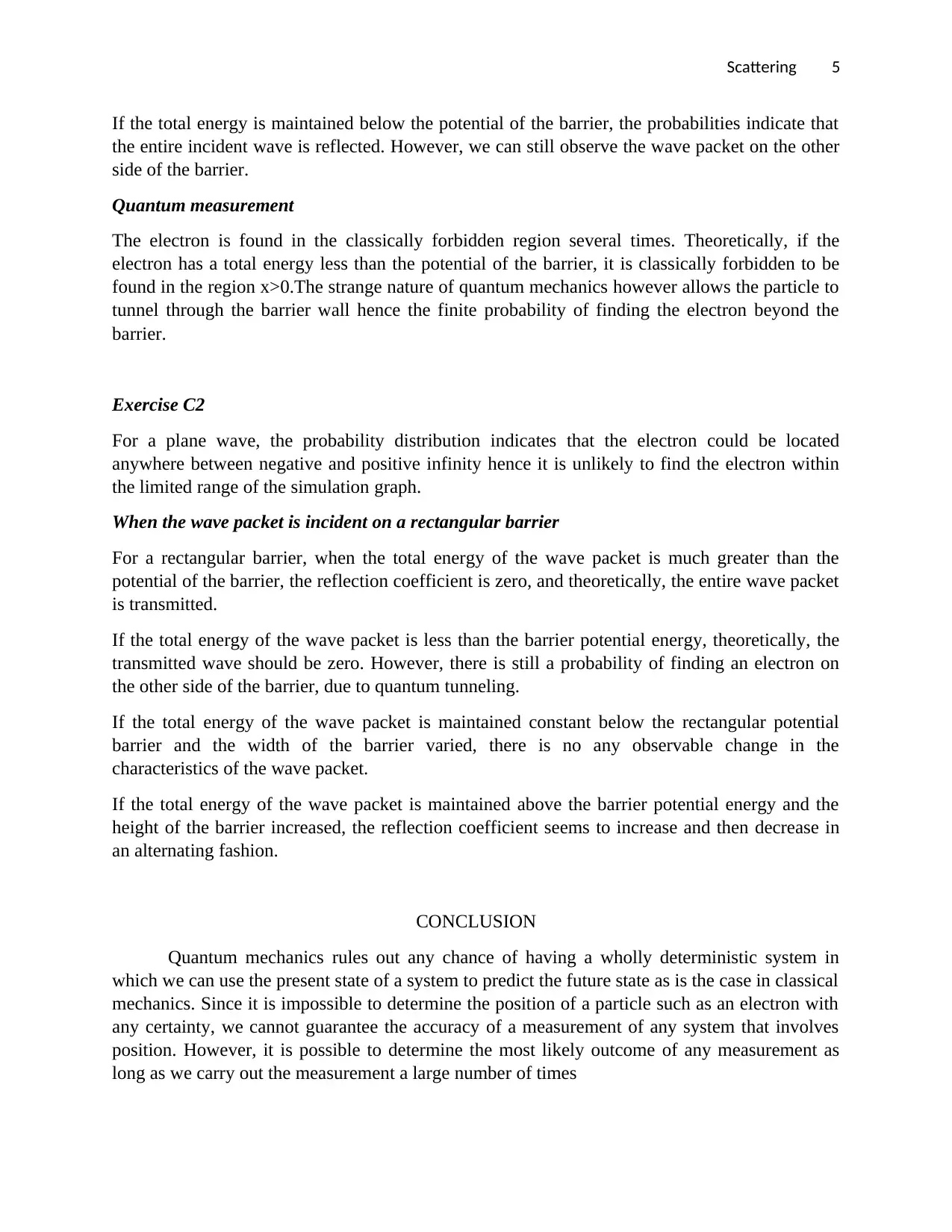
Scattering 5
If the total energy is maintained below the potential of the barrier, the probabilities indicate that
the entire incident wave is reflected. However, we can still observe the wave packet on the other
side of the barrier.
Quantum measurement
The electron is found in the classically forbidden region several times. Theoretically, if the
electron has a total energy less than the potential of the barrier, it is classically forbidden to be
found in the region x>0.The strange nature of quantum mechanics however allows the particle to
tunnel through the barrier wall hence the finite probability of finding the electron beyond the
barrier.
Exercise C2
For a plane wave, the probability distribution indicates that the electron could be located
anywhere between negative and positive infinity hence it is unlikely to find the electron within
the limited range of the simulation graph.
When the wave packet is incident on a rectangular barrier
For a rectangular barrier, when the total energy of the wave packet is much greater than the
potential of the barrier, the reflection coefficient is zero, and theoretically, the entire wave packet
is transmitted.
If the total energy of the wave packet is less than the barrier potential energy, theoretically, the
transmitted wave should be zero. However, there is still a probability of finding an electron on
the other side of the barrier, due to quantum tunneling.
If the total energy of the wave packet is maintained constant below the rectangular potential
barrier and the width of the barrier varied, there is no any observable change in the
characteristics of the wave packet.
If the total energy of the wave packet is maintained above the barrier potential energy and the
height of the barrier increased, the reflection coefficient seems to increase and then decrease in
an alternating fashion.
CONCLUSION
Quantum mechanics rules out any chance of having a wholly deterministic system in
which we can use the present state of a system to predict the future state as is the case in classical
mechanics. Since it is impossible to determine the position of a particle such as an electron with
any certainty, we cannot guarantee the accuracy of a measurement of any system that involves
position. However, it is possible to determine the most likely outcome of any measurement as
long as we carry out the measurement a large number of times
If the total energy is maintained below the potential of the barrier, the probabilities indicate that
the entire incident wave is reflected. However, we can still observe the wave packet on the other
side of the barrier.
Quantum measurement
The electron is found in the classically forbidden region several times. Theoretically, if the
electron has a total energy less than the potential of the barrier, it is classically forbidden to be
found in the region x>0.The strange nature of quantum mechanics however allows the particle to
tunnel through the barrier wall hence the finite probability of finding the electron beyond the
barrier.
Exercise C2
For a plane wave, the probability distribution indicates that the electron could be located
anywhere between negative and positive infinity hence it is unlikely to find the electron within
the limited range of the simulation graph.
When the wave packet is incident on a rectangular barrier
For a rectangular barrier, when the total energy of the wave packet is much greater than the
potential of the barrier, the reflection coefficient is zero, and theoretically, the entire wave packet
is transmitted.
If the total energy of the wave packet is less than the barrier potential energy, theoretically, the
transmitted wave should be zero. However, there is still a probability of finding an electron on
the other side of the barrier, due to quantum tunneling.
If the total energy of the wave packet is maintained constant below the rectangular potential
barrier and the width of the barrier varied, there is no any observable change in the
characteristics of the wave packet.
If the total energy of the wave packet is maintained above the barrier potential energy and the
height of the barrier increased, the reflection coefficient seems to increase and then decrease in
an alternating fashion.
CONCLUSION
Quantum mechanics rules out any chance of having a wholly deterministic system in
which we can use the present state of a system to predict the future state as is the case in classical
mechanics. Since it is impossible to determine the position of a particle such as an electron with
any certainty, we cannot guarantee the accuracy of a measurement of any system that involves
position. However, it is possible to determine the most likely outcome of any measurement as
long as we carry out the measurement a large number of times
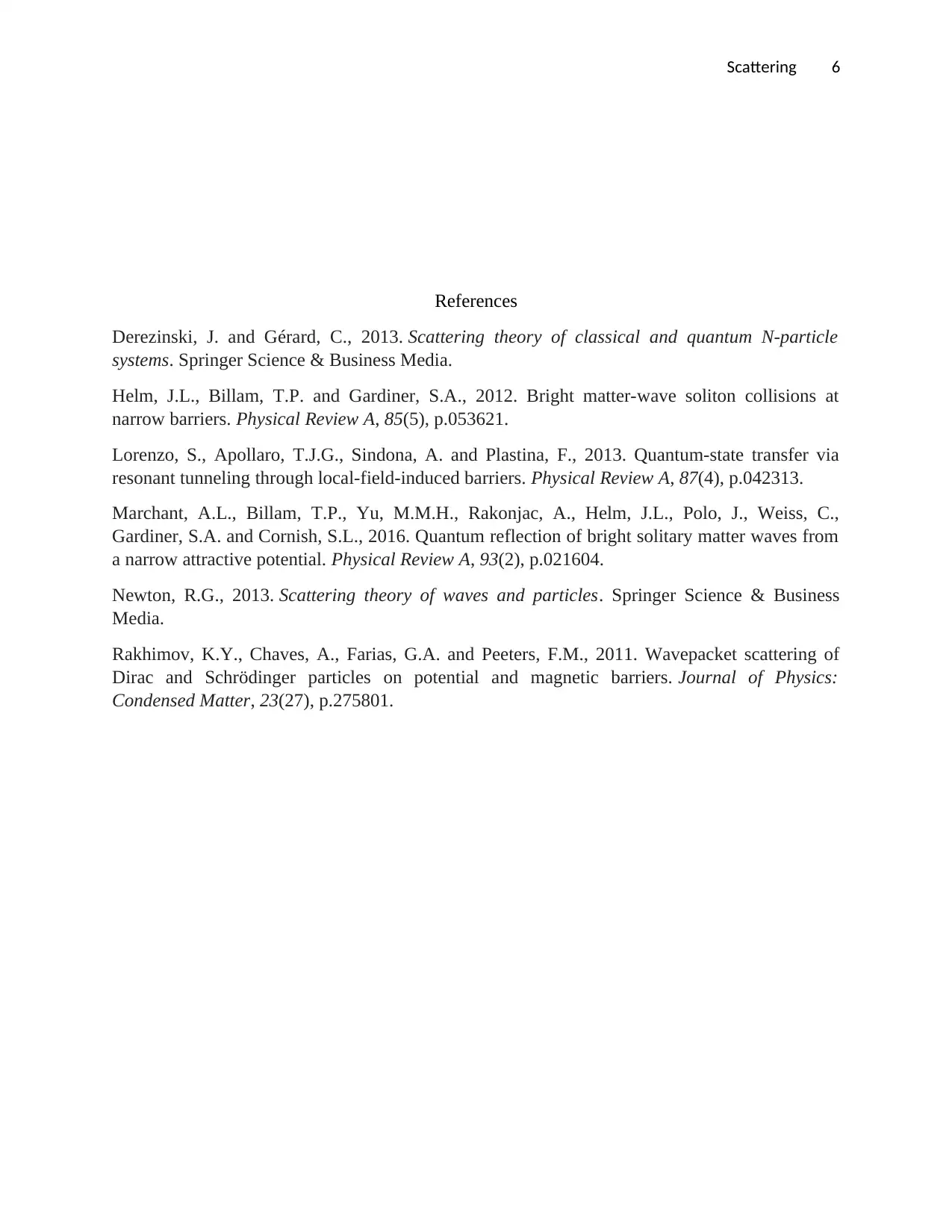
Scattering 6
References
Derezinski, J. and Gérard, C., 2013. Scattering theory of classical and quantum N-particle
systems. Springer Science & Business Media.
Helm, J.L., Billam, T.P. and Gardiner, S.A., 2012. Bright matter-wave soliton collisions at
narrow barriers. Physical Review A, 85(5), p.053621.
Lorenzo, S., Apollaro, T.J.G., Sindona, A. and Plastina, F., 2013. Quantum-state transfer via
resonant tunneling through local-field-induced barriers. Physical Review A, 87(4), p.042313.
Marchant, A.L., Billam, T.P., Yu, M.M.H., Rakonjac, A., Helm, J.L., Polo, J., Weiss, C.,
Gardiner, S.A. and Cornish, S.L., 2016. Quantum reflection of bright solitary matter waves from
a narrow attractive potential. Physical Review A, 93(2), p.021604.
Newton, R.G., 2013. Scattering theory of waves and particles. Springer Science & Business
Media.
Rakhimov, K.Y., Chaves, A., Farias, G.A. and Peeters, F.M., 2011. Wavepacket scattering of
Dirac and Schrödinger particles on potential and magnetic barriers. Journal of Physics:
Condensed Matter, 23(27), p.275801.
References
Derezinski, J. and Gérard, C., 2013. Scattering theory of classical and quantum N-particle
systems. Springer Science & Business Media.
Helm, J.L., Billam, T.P. and Gardiner, S.A., 2012. Bright matter-wave soliton collisions at
narrow barriers. Physical Review A, 85(5), p.053621.
Lorenzo, S., Apollaro, T.J.G., Sindona, A. and Plastina, F., 2013. Quantum-state transfer via
resonant tunneling through local-field-induced barriers. Physical Review A, 87(4), p.042313.
Marchant, A.L., Billam, T.P., Yu, M.M.H., Rakonjac, A., Helm, J.L., Polo, J., Weiss, C.,
Gardiner, S.A. and Cornish, S.L., 2016. Quantum reflection of bright solitary matter waves from
a narrow attractive potential. Physical Review A, 93(2), p.021604.
Newton, R.G., 2013. Scattering theory of waves and particles. Springer Science & Business
Media.
Rakhimov, K.Y., Chaves, A., Farias, G.A. and Peeters, F.M., 2011. Wavepacket scattering of
Dirac and Schrödinger particles on potential and magnetic barriers. Journal of Physics:
Condensed Matter, 23(27), p.275801.
1 out of 7
Related Documents
Your All-in-One AI-Powered Toolkit for Academic Success.
+13062052269
info@desklib.com
Available 24*7 on WhatsApp / Email
![[object Object]](/_next/static/media/star-bottom.7253800d.svg)
Unlock your academic potential
© 2024 | Zucol Services PVT LTD | All rights reserved.





